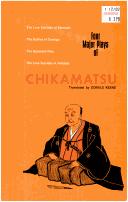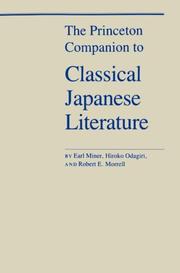| Listing 1 - 10 of 12 | << page >> |
Sort by
|
Book
ISBN: 4586540443 Year: 1992 Publisher: Osaka Hoikusha
Abstract | Keywords | Export | Availability | Bookmark
 Loading...
Loading...Choose an application
- Reference Manager
- EndNote
- RefWorks (Direct export to RefWorks)
Book
ISBN: 9780367516772 9780367150624 036715062X 0367516772 Year: 2021 Publisher: Abingdon: Routledge,
Abstract | Keywords | Export | Availability | Bookmark
 Loading...
Loading...Choose an application
- Reference Manager
- EndNote
- RefWorks (Direct export to RefWorks)
Bunraku has fascinated theatre practitioners through its particular forms of staging, such as highly elaborated manipulation of puppets and exquisite coordination of chanters and shamisen players. However, Bunraku lacks scholarship dedicated to translating not only the language but also cultural barriers of this work.In this book, Odanaka and Iwai tackle the wealth of bunraku plays underrepresented in English through rexamining their siginifcance on a global scale. Little is written on the fact that bunraku theatre, despites its elegant figures of puppets and exotic stories, was often made as a place to manifest the political concerns of playwrights in the 18th century, hence a reflection of the audience's expectation that could not have materialized outside the theatre.Japanese Political Theatre in the 18th Century aims to make bunraku texts readable for those who are interested in the political and cultural implications of this revered theatre tradition.
Bunraku - Japan - History - 18th century --- Bunraku --- Theater --- Dramatics --- Histrionics --- Professional theater --- Stage --- Theatre --- Performing arts --- Acting --- Actors --- Puppet jōruri --- Puppet theater --- History --- J6837 --- J5830 --- Japan: Performing arts and entertainment -- puppet plays, bunraku, jōruri --- Japan: Literature -- drama -- jōruri and bunraku
Book
ISBN: 3925944230 Year: 1987 Publisher: Marburg Hitzeroth
Abstract | Keywords | Export | Availability | Bookmark
Book
Year: 1966 Publisher: Toronto New York The New York Public Library The New American Library
Abstract | Keywords | Export | Availability | Bookmark
 Loading...
Loading...Choose an application
- Reference Manager
- EndNote
- RefWorks (Direct export to RefWorks)

ISBN: 0231035314 Year: 1971 Publisher: New York, NY : Columbia University Press,
Abstract | Keywords | Export | Availability | Bookmark
 Loading...
Loading...Choose an application
- Reference Manager
- EndNote
- RefWorks (Direct export to RefWorks)

ISBN: 0231085532 9780231085533 Year: 1961 Publisher: New York: Columbia university press,
Abstract | Keywords | Export | Availability | Bookmark
 Loading...
Loading...Choose an application
- Reference Manager
- EndNote
- RefWorks (Direct export to RefWorks)
Book
ISBN: 0824871413 9780824871413 9780824837259 9780824835620 9780824836801 082483562X 0824837258 Year: 2012 Publisher: Honolulu
Abstract | Keywords | Export | Availability | Bookmark
 Loading...
Loading...Choose an application
- Reference Manager
- EndNote
- RefWorks (Direct export to RefWorks)
"The plays presented here were first performed between 1769 and 1832, a time when the Japanese puppet theatre known as Bunraku was beginning to lose its pre-eminence to Kabuki. During this period, however, several important puppet plays were created that went on to become standards in both the Bunraku and Kabuki repertoires; three of the plays in this volume achieved this level of importance. This span of some sixty-odd years was also a formative one in the development of how plays were presented, an important feature in the modern staging of works from the traditional plebeian theatre. Only a handful of complete and uncut plays-often as much as ten hours long-are produced in Bunraku or Kabuki nowadays; included here is one of these. Two among the four plays contained in this volume are examples of the much more common practice of staging a single popular act or scene from a much longer drama that itself is seldom, if ever, performed in its entirety today.Kabuki, while better known outside Japan, has been a great beneficiary of the puppet theatre, borrowing perhaps as much as half of its body of work from Bunraku dramas. Bunraku, in turn, has raided the Kabuki repertoire but to a far more modest degree. The final play in this collection, The True Tale of Asagao, is an instance of this uncommon reverse borrowing. Moreover, it is an example of yet another way in which some plays have come to be presented: a coherent subplot of a longer work that gained an independent theatrical existence while its parent drama has since disappeared from the stage. These later eighteenth-century works display a continued development toward greater attention to the theatrical features of puppet plays as opposed to the earlier, more literary approach found most notably in the dramas of Chikamatsu Monzaemon (d. 1725). Newly translated and illustrated for the general reader and the specialist, the plays in this volume are accompanied by informative introductions, extensive notes on stage action, and discussions of the various changes that Bunraku underwent, particularly in the latter half of the eighteenth century, its golden age." -- Publisher's description.
Bunraku --- Puppet plays, Japanese --- Jōruri --- Bunraku plays --- Jōruri puppet plays --- Japanese puppet plays --- Japanese drama --- Puppet jōruri --- Puppet theater --- History. --- History

ISBN: 0231074190 0231074182 9780231074186 9780231074193 Year: 1990 Publisher: New York Columbia University Press
Abstract | Keywords | Export | Availability | Bookmark
 Loading...
Loading...Choose an application
- Reference Manager
- EndNote
- RefWorks (Direct export to RefWorks)
Donald Keene combines informative works on two forms of classical Japanese theater into a single volume. The No text looks at all aspects of this traditional theater form including its history, its stage and props, the use of music and dance in its performances, the plays as literature, and the aesthetics of No. Also discussed are Kyogen, the comic farces that are typically interspersed with the solemn No dramas.
Theatrical science --- Japan --- Nō --- Bunraku --- J6834 --- J6837 --- Puppet jōruri --- Puppet theater --- Noh --- Shimai --- Theater --- Japan: Performing arts and entertainment -- nō and kyōgen (noh) --- Japan: Performing arts and entertainment -- puppet plays, bunraku, jōruri --- Nô --- Théâtre de marionnettes --- Japon.
Book
ISBN: 0824807936 Year: 1982 Publisher: Honolulu, Hawaii
Abstract | Keywords | Export | Availability | Bookmark
 Loading...
Loading...Choose an application
- Reference Manager
- EndNote
- RefWorks (Direct export to RefWorks)
Kabuki --- Puppets --- J5820 --- J5830 --- J6835 --- J6837 --- Theater --- Puppets and puppet-plays --- Puppet theater --- History and criticism --- Japan: Literature -- drama -- kabuki --- Japan: Literature -- drama -- jōruri and bunraku --- Japan: Performing arts and entertainment -- kabuki --- Japan: Performing arts and entertainment -- puppet plays, bunraku, jōruri --- Takeda, Izumo, --- Theatrical science --- Asian literature --- Chueshingura --- Japan

ISBN: 0691008256 0691065993 0691218382 Year: 1985 Publisher: Princeton (N.J.) : Princeton university press,
Abstract | Keywords | Export | Availability | Bookmark
 Loading...
Loading...Choose an application
- Reference Manager
- EndNote
- RefWorks (Direct export to RefWorks)
The description for this book, The Princeton Companion to Classical Japanese Literature, will be forthcoming.
J0930.10 --- Japan: Books and magazines -- history -- earliest, premodern --- J5500.10 --- Japan: Literature -- history and criticism -- premodern, ancient and earliest --- Japanese literature --- History and criticism. --- Abe no Nakamaro. --- Adachigahara. --- Ariwara Narihira. --- Bodhidharma. --- Buddhism. --- China and Chinese literature. --- Confucianism. --- Dōjōji. --- Eboshiori. --- Eiga Monogatari. --- Enomoto Kikaku. --- Fudoki (Topographies). --- Fugashū, Funa Benkei. --- Fūshikaden. --- Genji Monogatari. --- Genroku period. --- Gotoba (tennō). --- Hachimonjiya. --- Haikai Revival. --- Heike Monogatari. --- Hiraga Gennai. --- Ietaka (Fujiwara Ietaka). --- Imagawa Ryōshun. --- Izumi Shikibu. --- Kaidōki. --- Kakinomoto Hitomaro. --- Matsunaga Teitoku. --- Matsuo Bashō. --- Naniwa Miyage. --- Ochikubo Monogatari. --- Oino Kobumi. --- Reizei poets. --- Saigyō. --- ageku. --- bunraku. --- daisan (third stanza). --- gagaku (elegant music). --- gempei. --- jidaimono. --- jōruri. --- kanshi. --- kokindenju. --- maeku.
| Listing 1 - 10 of 12 | << page >> |
Sort by
|

 Search
Search Feedback
Feedback About UniCat
About UniCat  Help
Help News
News